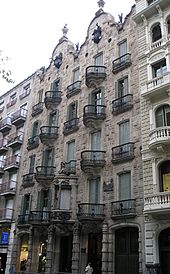Casa Calvet facts for kids
Quick facts for kids Casa Calvet |
|
|---|---|
 |
|
| General information | |
| Architectural style | Modernisme |
| Location | Barcelona, Spain |
| Construction started | 1898 |
| Completed | 1900 |
| Design and construction | |
| Architect | Antoni Gaudí |
| Type: | Non-movable |
| Criteria: | Monument |
| Designated: | 24 July 1969 |
| Reference #: | RI-51-0003819 |
The Casa Calvet is a famous building in Barcelona, Spain. It was designed by the well-known architect Antoni Gaudí. This building was made for a textile manufacturer named Andreu Calvet. It served two purposes: the ground floor and basement were used for business, while the upper floors were homes. It was built between 1898 and 1900.
Gaudí is known for his unique and often wild designs. However, many experts agree that Casa Calvet is one of his more "normal" buildings. This might be because it was built between older buildings. It also sits in a very fancy part of Barcelona. Unlike some of Gaudí's other works, Casa Calvet looks quite balanced and orderly. But don't worry, it still has some of his special touches!
Contents
What Makes Casa Calvet Special?
Even though it's more traditional, Casa Calvet has many cool features that show Gaudí's Modernisme style. Modernisme was a popular art movement in Catalonia, Spain, similar to Art Nouveau. It focused on natural shapes and fancy decorations.
Unique Design Elements
- Curvy Roof: Look at the top of the building! It has interesting curves and a double gable shape. This is a classic Gaudí touch.
- Fancy Entrance: The entrance has a special projecting window, called an oriel. It looks almost like something from a grand old palace.
- Hidden Meanings: Gaudí often added small, clever details. Above the oriel, you can spot carved mushrooms. These were a nod to the owner's favorite hobby, mushroom hunting!
Details on the Facade
- Balconies: The building has different kinds of balconies. Some stick out far, while others are smaller and flatter. This creates an interesting pattern.
- Columns: The columns next to the entrance look like stacked bobbins. Bobbins are spools of thread used in textile factories. This was a clever way to show the owner's family business!
- Stone and Ironwork: The ground floor gallery is very impressive. It mixes stone and fancy wrought iron. You can see detailed carvings of a cypress tree, an olive tree, and "horns of plenty" (which symbolize good luck and lots of food). You can also spot the Catalan coat of arms.
Sculpted Heads
At the very top of the building, there are three sculpted heads. These also have a special meaning for the owner:
- One head is of Sant Pere Màrtir Calvet i Carbonell, who was the owner's father.
- The other two heads represent the patron saints of Vilassar de Mar, which was Andreu Calvet's hometown. Patron saints are special protectors of a place or person.
Awards and Recognition
Casa Calvet was recognized for its artistic design. Between 1899 and 1906, it won an award called the "Arts Building Annual Award" (Concurso annual de edificios artísticos). This award celebrated beautiful Modernisme buildings, and Casa Calvet was in good company, winning alongside other famous buildings like the Casa Lleó Morera and the Casa Trinxet.
See also
 In Spanish: Casa Calvet para niños
In Spanish: Casa Calvet para niños
- List of Modernisme buildings in Barcelona

